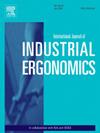Assessing the link between occupational risk factors, work-related musculoskeletal disorders and quality of work life: An analysis using PLS-SEM
IF 2.5
2区 工程技术
Q2 ENGINEERING, INDUSTRIAL
International Journal of Industrial Ergonomics
Pub Date : 2024-11-01
DOI:10.1016/j.ergon.2024.103658
引用次数: 0
Abstract
This article aimed to test the hypotheses of a complex model considering the chain relationship between occupational risk factors, work-related musculoskeletal disorders (WMSDs) symptoms, and Quality of Work Life (QWL) perceived by workers. We assessed psychosocial risk factors utilizing items from the Job Content Questionnaire, the Effort-Reward Imbalance Questionnaire, and the Copenhagen Psychosocial Questionnaire II. The biomechanical factors analyzed included poor trunk and upper limb postures, excessive lifting, and prolonged standing. Organizational factors evaluated were monotonous work, tight deadlines, and low stimulation for teamwork. Using the Nordic and Walton Questionnaires, we assessed workers’ perceptions of WMSD symptoms and QWL. We constructed the model using the Partial Least Squares Structural Equation Modeling (PLS-SEM) approach. The measurement model assessed reliability (composite reliability) and validity tests (average variance extracted, Heterotrait-Monotrait ratio of correlations method, and Fornell-Larcker criterion). The structural model analyzed direct and indirect paths between factors and tested the hypotheses (bootstrapping method). Results indicate that most biomechanical factors affect WMSDs mediated by physical work demands. Physical work demands have a direct impact on WMSDs and stress. Good psychosocial conditions alleviate stress, reduce WMSD symptoms, and increase QWL. Harmful organizational factors acted indirectly on WRMSDs, amplifying stress perception. Finally, WMSDs worsen QWL. We concluded that the model is valid with satisfactory psychometrics for measuring and relating risk factors, WMSDs, and QWL, providing insights that can guide professionals and researchers in planning and implementing actions to prevent risks and WMSD symptoms and improve QWL.
评估职业风险因素、与工作有关的肌肉骨骼疾病和工作生活质量之间的联系:使用 PLS-SEM 进行分析
本文旨在检验一个复杂模型的假设,该模型考虑了职业风险因素、与工作相关的肌肉骨骼疾病(WMSDs)症状和工人感知的工作生活质量(QWL)之间的连锁关系。我们利用工作内容问卷、努力-回报不平衡问卷和哥本哈根社会心理问卷 II 中的项目对社会心理风险因素进行了评估。分析的生物力学因素包括躯干和上肢姿势不良、过度举重和长时间站立。评估的组织因素包括单调的工作、紧迫的截止日期和对团队合作的低刺激。我们使用北欧和沃尔顿问卷评估了工人对 WMSD 症状和 QWL 的看法。我们使用偏最小二乘法结构方程模型(PLS-SEM)方法构建了模型。测量模型评估了信度(综合信度)和效度检验(平均方差提取、异方差-单方差相关比方法和 Fornell-Larcker 标准)。结构模型分析了因子间的直接和间接路径,并对假设进行了检验(引导法)。结果表明,大多数生物力学因素对 WMSDs 的影响都以体力工作需求为中介。体力工作要求对 WMSDs 和压力有直接影响。良好的社会心理条件可减轻压力,减少 WMSD 症状,提高 QWL。有害的组织因素会间接影响 WRMSDs,放大压力感知。最后,WMSDs 会恶化 QWL。我们的结论是,该模型在测量和关联风险因素、WMSDs 和 QWL 方面具有令人满意的心理计量学效果,可以为专业人员和研究人员规划和实施预防风险和 WMSD 症状以及改善 QWL 的行动提供指导。
本文章由计算机程序翻译,如有差异,请以英文原文为准。
求助全文
约1分钟内获得全文
求助全文
来源期刊
CiteScore
6.40
自引率
12.90%
发文量
110
审稿时长
56 days
期刊介绍:
The journal publishes original contributions that add to our understanding of the role of humans in today systems and the interactions thereof with various system components. The journal typically covers the following areas: industrial and occupational ergonomics, design of systems, tools and equipment, human performance measurement and modeling, human productivity, humans in technologically complex systems, and safety. The focus of the articles includes basic theoretical advances, applications, case studies, new methodologies and procedures; and empirical studies.

 求助内容:
求助内容: 应助结果提醒方式:
应助结果提醒方式:


